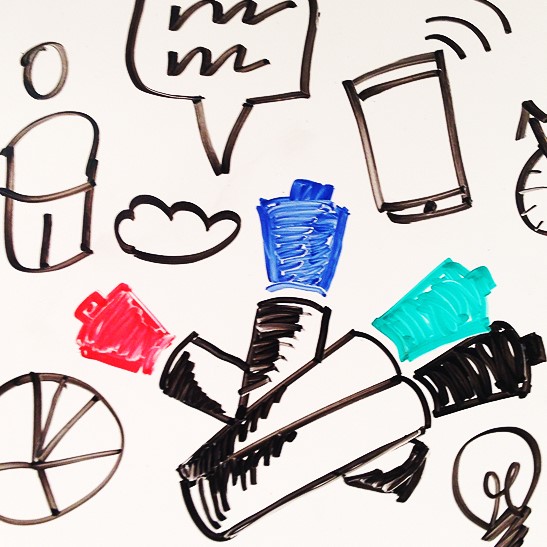Have you ever sat in a meeting about complex relationships without really understanding how the pieces fit together? Did the leader ever scratch out a drawing that made it all become clear, in a way that words alone could not capture? I’ve been in those meetings and was struck by how much a simple drawing can help. That led me to this exploration of whiteboarding and how we can all use it to improve how we get ideas across to our audiences.
Drawings and sketches work because they make the abstract more accessible and bring form to ideas. “But, wait!” you say, “I’m not a designer! I can’t draw!” Fear not. There is no secret whiteboarding club. The drawing is not about you and your drawing prowess or lack thereof. It’s about having better conversations and communication because people can see – not just hear – what you’re talking about.
This is the first blog in a 4-part series that will provide insight into why whiteboarding works, help you develop your own whiteboarding style and run meetings visually to help make them more engaging and more productive.
Part 1. Why Drawing Works
Part 2. Whiteboarding Quick Starter
Part 3. Diagram Types
Part 4. Running a Successful Visual Meeting
Part 1: Why Drawing Works
When you draw something on a whiteboard you’re putting yourself out there in front of the group. Even if you haven’t said anything, you’re taking the first step to collaborate and start a conversation. Good things happen when you draw, such as:
· Engaging the participants
· Focusing conversation
· Creating a visual record
· Capturing many perspectives
· Minimizing friction
Engaging Participants. People will pay attention to what you draw. It’s our basic human instinct. Our brains are wired to find patterns and fill in the blanks. Drawings attract everyone, not just the folks with the loudest voice or the strongest opinions. Drawings are a kind of puzzle that everyone in a group can work on collaboratively.
Perfection isn’t necessary or even desirable. An incomplete or inaccurate drawing goes a lot further than you might think. In fact, an imperfect drawing encourages people to get it right, start correcting it and suddenly they are invested in the idea. You have engaged them. Often you can hand them a marker and ask them to help fill in some of the missing details.

Focusing Conversations. In a lively group, the conversation can jump quickly from one topic to another. This can be good: together we can generate more and ultimately better ideas than one person alone. But it can get out of hand. At other times, people will join the meeting late and need an update. These are occasions to recap, summarize and nudge the conversation to stay on point. If you’ve been capturing the discussion visually, try to connect and incorporate the conversation’s themes with the drawing. Even if you don’t see the connection immediately, a participant might. Either way, you can use the drawing to reorient and refocus the meeting.
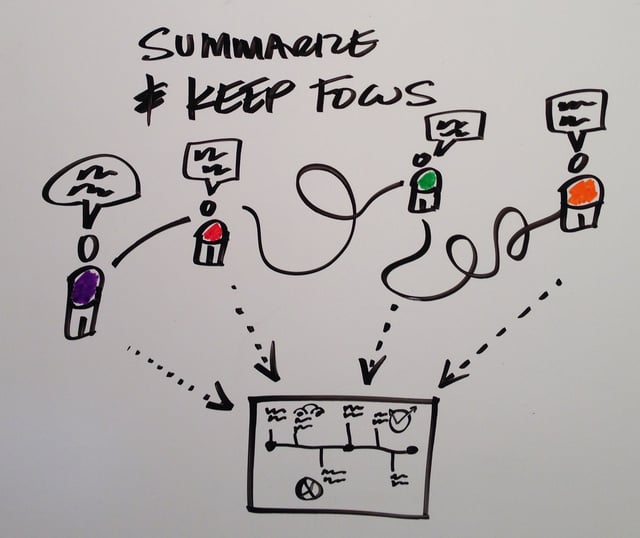
Creating A Visual Record. People sometimes refer to themselves as “visual thinkers” or say that they are “visual learners.” Research supports the power of engaging people visually.
Dr. Lynell Burmark, Ph.D. Associate at the Thornburg Center for Professional Development and writer of several books and papers on visual literacy says,
“…unless our words, concepts, ideas are hooked onto an image, they will go in one ear, sail through the brain, and go out the other ear. Words are processed by our short-term memory where we can only retain about 7 bits of information (plus or minus 2) […]. Images, on the other hand, go directly into long-term memory where they are indelibly etched.”
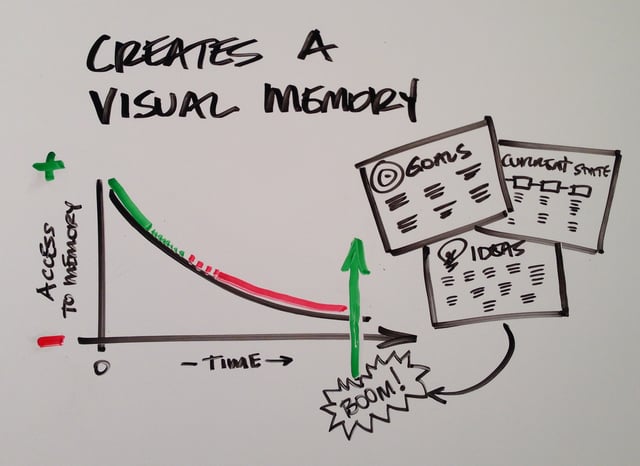
To etch your ideas into participants’ memory, take pictures of the whiteboard at the end of the meeting (or before you erase it during the meeting). Share the pictures with all attendees. In addition to creating a visual memory, the pictures will also document the discussion. They provide evidence in a neutral tone (no sarcasm in drawings) and create accountability. There’s no “I never said that” in a drawing.
Capturing Many Perspectives. Complex problems often involve many areas of a business. A diagram can both tease apart different perspectives and connect them to show how they work in concert. Think about mapping a company’s relationship with its customers. The story from a customer’s perspective will be very different from the internal view. A drawing naturally lends itself to laying out departments, roles andtechnology and adding “layers” to highlight pain points, priorities, release strategies, organizational readiness and more. The drawing can illustrate where participants’ views are closest and where they diverge most significantly.
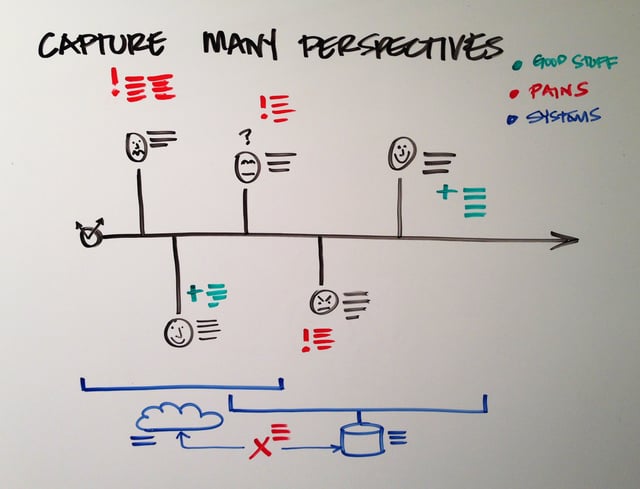
Minimizing Friction. Sometimes one person’s or group’s agenda will conflict with others. Combine that with history or predisposition to disagree, and the tension can quickly change the tone of a meeting. All of the attributes of drawing discussed above come into play to deal with situations like this. If you frame the challenge visually, people can change their focus to “getting the picture right” instead of “why you are wrong.” Here is an example...
On a recent project, the IT Director was in discussion with a vendor regarding a multi-year partnership. The VP of Marketing was concerned about committing to a technology platform that would not allow them to run targeted campaigns and understand their customers in meaningful ways. To focus the conversation, we used a journey map to capture how they wanted to engage with their customers, learn from these interactions and develop stronger relationships by communicating in more relevant and personalized ways. This gave us a focal point for defining needs, evaluating potential tools and identifying what needed to change.
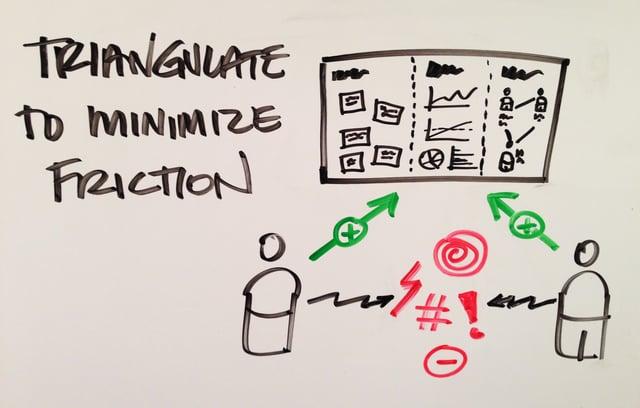
Ready for Your First Assignment? I’ve outlined the upside for having meetings that are more visual. Now, I’d like you to try something with me. Make a whiteboard drawing that will help someone learn about:
1. what to consider when planning a commute to work (mode of transport, route, timing, etc.)
2. how family / friends together decide what to eat for dinner and where
3. how people choose what to wear for the day
TIP: if you’re not sure about committing to a drawing, draw or write words on sticky notes first and move them around until you’re happy with their placement and relationships. You can stop there or remove the sticky notes and draw your diagram on the board. I am curious what you have. Email me with your drawing and I will share my drawing with you.
Stay tuned for the next post in this series, “Whiteboarding Quickstarter” where we’ll introduce some drawing calisthenics and work on building habits that will continue to improve your drawing chops.
Cool AND relevant links:
- Neural correlates of the episodic encoding of pictures and words
http://www.pnas.org/content/95/5/2703.full - 3 benefits of visual mapping in meetings
http://mindmappingsoftwareblog.com/3-benefits-of-visual-mapping-in-meetings/ - The Benefits of Graphic Facilitation: More Than Just Pretty Pictures!
http://www.makemark.com/articles/BENEFITS%20OF%20GRAPHIC%20FACILITATION%20V21.pdf - Say It With Stick Figures: Your Crude Drawings Are More Effective Than PowerPoint
http://www.bloomberg.com/bw/articles/2014-07-10/say-it-with-stick-figures-your-crude-drawings-are-more-effective-than-powerpoint - The Picture Superiority Effect
https://en.wikipedia.org/wiki/Picture_superiority_effect - We process visuals 60,000 times faster than text – Here’s WHY
https://rhdeepexploration.wordpress.com/2011/12/05/visuals-60000-times-faster/ - Visual Facilitation: 3 Key Benefits of Using Visuals in Strategic Meetings
http://www.theringeffect.com/blog/item/visual-facilitation-3-key-benefits-of-using-visuals-in-strategic-meetings - Visual, Auditory, and Kinesthetic Learning Styles (VAK)
http://www.nwlink.com/~donclark/hrd/styles/vakt.html - VAK
http://www.brainboxx.co.uk/a3_aspects/pages/VAK.htm - The 3 reasons why you can’t draw, (and what to do about it)
http://willkempartschool.com/the-3-reasons-why-you-cant-draw-and-what-to-do-about-it/ - Making It Stick: Memorable Strategies to Enhance Learning
http://www.ldonline.org/article/5602/ - What Makes a Visualization Memorable?
http://cvcl.mit.edu/papers/Borkin_etal_MemorableVisualization_TVCG2013.pdf
